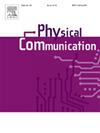A security enhancement analysis of full duplex cooperative rate-splitting
IF 2
4区 计算机科学
Q3 ENGINEERING, ELECTRICAL & ELECTRONIC
引用次数: 0
Abstract
Message security is crucial for full-duplex (FD) cooperative rate splitting (CRS) system. Since the remote user’s common message can be decoded by the relay user, and the near user needs to be transmitted as a relay, it is necessary to prevent the remote user’s private message from being eavesdropped by the near user. In addition, the remote user must also prevent the potential external eavesdropper from eavesdropping on his message. Therefore, this paper considers the security performance of remote user in FD-CRS networks facing both external eavesdropping and internal eavesdropping. We aim to maximize the remote user security rate under the constraints of transmission power and common rate allocation. Due to the non-convexity of the problem, we propose an iterative algorithm based on successive convex approximation (SCA) to solve it. Our simulation results show that the FD-CRS significantly outperforms half-duplex (HD)-CRS and non-cooperative schemes in terms of security.
全双工协同速率分割的安全性增强分析
消息安全是全双工(FD)协同速率分割(CRS)系统的关键。由于远端用户的公用报文可以被中继用户解码,而近端用户又需要作为中继进行传输,因此有必要防止远端用户的私报文被近端用户窃听。此外,远程用户还必须防止潜在的外部窃听者窃听他的消息。因此,本文考虑了FD-CRS网络中面对外部窃听和内部窃听的远程用户的安全性能。我们的目标是在传输功率和公共速率分配的约束下最大化远程用户的安全速率。由于该问题的非凸性,我们提出了一种基于连续凸逼近(SCA)的迭代算法来求解该问题。仿真结果表明,FD-CRS在安全性方面明显优于半双工(HD)-CRS和非合作方案。
本文章由计算机程序翻译,如有差异,请以英文原文为准。
求助全文
约1分钟内获得全文
求助全文
来源期刊

Physical Communication
ENGINEERING, ELECTRICAL & ELECTRONICTELECO-TELECOMMUNICATIONS
CiteScore
5.00
自引率
9.10%
发文量
212
审稿时长
55 days
期刊介绍:
PHYCOM: Physical Communication is an international and archival journal providing complete coverage of all topics of interest to those involved in all aspects of physical layer communications. Theoretical research contributions presenting new techniques, concepts or analyses, applied contributions reporting on experiences and experiments, and tutorials are published.
Topics of interest include but are not limited to:
Physical layer issues of Wireless Local Area Networks, WiMAX, Wireless Mesh Networks, Sensor and Ad Hoc Networks, PCS Systems; Radio access protocols and algorithms for the physical layer; Spread Spectrum Communications; Channel Modeling; Detection and Estimation; Modulation and Coding; Multiplexing and Carrier Techniques; Broadband Wireless Communications; Wireless Personal Communications; Multi-user Detection; Signal Separation and Interference rejection: Multimedia Communications over Wireless; DSP Applications to Wireless Systems; Experimental and Prototype Results; Multiple Access Techniques; Space-time Processing; Synchronization Techniques; Error Control Techniques; Cryptography; Software Radios; Tracking; Resource Allocation and Inference Management; Multi-rate and Multi-carrier Communications; Cross layer Design and Optimization; Propagation and Channel Characterization; OFDM Systems; MIMO Systems; Ultra-Wideband Communications; Cognitive Radio System Architectures; Platforms and Hardware Implementations for the Support of Cognitive, Radio Systems; Cognitive Radio Resource Management and Dynamic Spectrum Sharing.
 求助内容:
求助内容: 应助结果提醒方式:
应助结果提醒方式:


